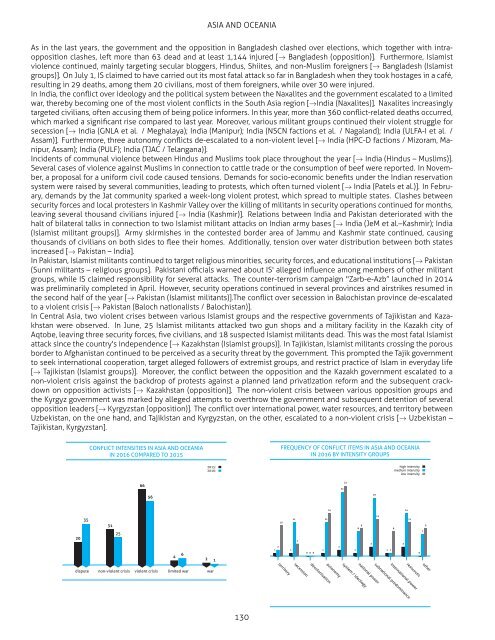ConflictBarometer_2016
ConflictBarometer_2016
ConflictBarometer_2016
Create successful ePaper yourself
Turn your PDF publications into a flip-book with our unique Google optimized e-Paper software.
ASIA AND OCEANIA<br />
As in the last years, the government and the opposition in Bangladesh clashed over elections, which together with intraopposition<br />
clashes, left more than 63 dead and at least 1,144 injured [→ Bangladesh (opposition)]. Furthermore, Islamist<br />
violence continued, mainly targeting secular bloggers, Hindus, Shiites, and non-Muslim foreigners [→ Bangladesh (Islamist<br />
groups)]. On July 1, IS claimed to have carried out its most fatal attack so far in Bangladesh when they took hostages in a café,<br />
resulting in 29 deaths, among them 20 civilians, most of them foreigners, while over 30 were injured.<br />
In India, the conflict over ideology and the political system between the Naxalites and the government escalated to a limited<br />
war, thereby becoming one of the most violent conflicts in the South Asia region [→India (Naxalites)]. Naxalites increasingly<br />
targeted civilians, often accusing them of being police informers. In this year, more than 360 conflict-related deaths occurred,<br />
which marked a significant rise compared to last year. Moreover, various militant groups continued their violent struggle for<br />
secession [→ India (GNLA et al. / Meghalaya); India (Manipur); India (NSCN factions et al. / Nagaland); India (ULFA-I et al. /<br />
Assam)]. Furthermore, three autonomy conflicts de-escalated to a non-violent level [→ India (HPC-D factions / Mizoram, Manipur,<br />
Assam); India (PULF); India (TJAC / Telangana)].<br />
Incidents of communal violence between Hindus and Muslims took place throughout the year [→ India (Hindus – Muslims)].<br />
Several cases of violence against Muslims in connection to cattle trade or the consumption of beef were reported. In November,<br />
a proposal for a uniform civil code caused tensions. Demands for socio-economic benefits under the Indian reservation<br />
system were raised by several communities, leading to protests, which often turned violent [→ India (Patels et al.)]. In February,<br />
demands by the Jat community sparked a week-long violent protest, which spread to multiple states. Clashes between<br />
security forces and local protesters in Kashmir Valley over the killing of militants in security operations continued for months,<br />
leaving several thousand civilians injured [→ India (Kashmir)]. Relations between India and Pakistan deteriorated with the<br />
halt of bilateral talks in connection to two Islamist militant attacks on Indian army bases [→ India (JeM et al.–Kashmir); India<br />
(Islamist militant groups)]. Army skirmishes in the contested border area of Jammu and Kashmir state continued, causing<br />
thousands of civilians on both sides to flee their homes. Additionally, tension over water distribution between both states<br />
increased [→ Pakistan – India].<br />
In Pakistan, Islamist militants continued to target religious minorities, security forces, and educational institutions [→ Pakistan<br />
(Sunni militants – religious groups]. Pakistani officials warned about IS' alleged influence among members of other militant<br />
groups, while IS claimed responsibility for several attacks. The counter-terrorism campaign ''Zarb-e-Azb” launched in 2014<br />
was preliminarily completed in April. However, security operations continued in several provinces and airstrikes resumed in<br />
the second half of the year [→ Pakistan (Islamist militants)].The conflict over secession in Balochistan province de-escalated<br />
to a violent crisis [→ Pakistan (Baloch nationalists / Balochistan)].<br />
In Central Asia, two violent crises between various Islamist groups and the respective governments of Tajikistan and Kazakhstan<br />
were observed. In June, 25 Islamist militants attacked two gun shops and a military facility in the Kazakh city of<br />
Aqtobe, leaving three security forces, five civilians, and 18 suspected Islamist militants dead. This was the most fatal Islamist<br />
attack since the country's independence [→ Kazakhstan (Islamist groups)]. In Tajikistan, Islamist militants crossing the porous<br />
border to Afghanistan continued to be perceived as a security threat by the government. This prompted the Tajik government<br />
to seek international cooperation, target alleged followers of extremist groups, and restrict practice of Islam in everyday life<br />
[→ Tajikistan (Islamist groups)]. Moreover, the conflict between the opposition and the Kazakh government escalated to a<br />
non-violent crisis against the backdrop of protests against a planned land privatization reform and the subsequent crackdown<br />
on opposition activists [→ Kazakhstan (opposition)]. The non-violent crisis between various opposition groups and<br />
the Kyrgyz government was marked by alleged attempts to overthrow the government and subsequent detention of several<br />
opposition leaders [→ Kyrgyzstan (opposition)]. The conflict over international power, water resources, and territory between<br />
Uzbekistan, on the one hand, and Tajikistan and Kyrgyzstan, on the other, escalated to a non-violent crisis [→ Uzbekistan –<br />
Tajikistan, Kyrgyzstan].<br />
CONFLICT INTENSITIES IN ASIA AND OCEANIA<br />
IN <strong>2016</strong> COMPARED TO 2015<br />
FREQUENCY OF CONFLICT ITEMS IN ASIA AND OCEANIA<br />
IN <strong>2016</strong> BY INTENSITY GROUPS<br />
2015:<br />
<strong>2016</strong>:<br />
high intensity<br />
medium intensity<br />
low intensity<br />
66<br />
21<br />
23<br />
56<br />
19<br />
14<br />
14<br />
20<br />
35<br />
31<br />
25<br />
4<br />
6<br />
2<br />
1<br />
2<br />
1<br />
10<br />
territory<br />
1<br />
11<br />
4<br />
secession<br />
0 0 0<br />
1<br />
11<br />
decolonisation<br />
autonomy<br />
2<br />
1<br />
9<br />
8<br />
system / ideology<br />
national power<br />
3<br />
12<br />
1 1<br />
8<br />
subnational predominance<br />
international power<br />
3<br />
11<br />
resources<br />
0<br />
7<br />
9<br />
other<br />
dispute non-violent crisis violent crisis limited war war<br />
130


